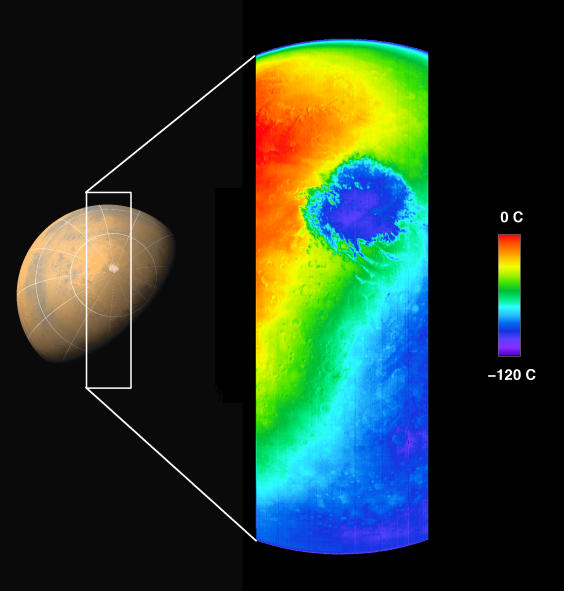Mars Odyssey’s First Look at Mars is all Treat, No Trick
NASA’s 2001 Mars Odyssey gave mission managers a real
treat this Halloween with its first look at the Red Planet.
It’s a thermal infrared image of the Martian southern
hemisphere that captures the polar carbon dioxide ice cap at
a temperature of about minus 120 C (minus 184 F).
The spacecraft first entered orbit around Mars last week
after a six-month, 285 million-mile journey.
The image, taken as part of the calibration process for the
instrument, shows the nighttime temperatures of Mars,
demonstrating the “night-vision” capability of the camera
system to observe Mars, even when the surface is in darkness.
“This spectacular first image of Mars from the 2001 Mars
Odyssey spacecraft is just a hint of what’s to come,” said
Dr. Ed Weiler, Associate Administrator for Space Science at
NASA Headquarters in Washington. “After we get Odyssey into
its final orbit it will be much closer to Mars than when it
took this image, and we’ll be able to tell whether or not
there are any hot springs on Mars, places where liquid water
may be close to the surface. If there are any such locations
they would be places we might like to explore on future
missions.”
The image covers a length of more than 6,500 kilometers
(3,900 miles), spanning the planet from limb to limb, with a
resolution of approximately 5.5 kilometers per pixel (3.4
miles per pixel), at the point directly beneath the
spacecraft.
The spacecraft was about 22,000 kilometers (about 13,600
miles) above the planet looking down toward the south pole of
Mars when the image was taken.
It is late spring in the Martian southern hemisphere. The
extremely cold, circular feature shown in blue is the Martian
south polar carbon dioxide ice cap , which is more than 900
kilometers (540 miles) in diameter at this time and will
continue to shrink as summer progresses. Clouds of cooler air
blowing off the cap can be seen in orange extending across
the image.
JPL manages the 2001 Mars Odyssey mission for NASA’s Office
of Space Science. The thermal-emission imaging system was
developed at Arizona State University, Tempe, with Raytheon
Santa Barbara Remote Sensing, Santa Barbara, Calif. Lockheed
Martin Astronautics, Denver, is the prime contractor for the
project, and developed and built the orbiter. Mission
operations are conducted jointly from Lockheed Martin and
from JPL, a division of the California Institute of
Technology in Pasadena.
The Mars Odyssey image is available on the Internet at:

This thermal infrared image was acquired by Mars Odyssey’s thermal emission
imaging system on October 30, 2001, as the spacecraft orbited Mars on its
ninth revolution around the planet. The image was taken as part of the
calibration and testing process of the camera system.
This image shows the temperature of Mars in one of the 10 thermal infrared
filters. The spacecraft was approximately 22,000 kilometers (about 13,600
miles) above the planet looking down toward the south pole of Mars when
this image was acquired.
It is late spring in the martian southern hemisphere. The extremely cold,
circular feature shown in blue is the martian south polar carbon dioxide
ice cap at a temperature of about -120 °C (-184 ° F). The cap is more
than 900 kilometers (540 miles) in diameter at this time and will continue
to shrink as summer progresses. Clouds of cooler air blowing off the cap
can be seen in orange extending across the image to the left of the cap.
The cold region in the lower right portion of the image shows the nighttime
temperatures of Mars, demonstrating the “night-vision” capability of the
camera system to observe Mars even when the surface is in darkness. The
warmest regions occur near local noontime. The ring of mountains
surrounding the 900-kilometer (540-mile) diameter impact basin Argyre can
be seen in the early afternoon in the upper portion of the image. The
thin blue crescent along the upper limb of the planet is the martian
atmosphere.
This image covers a length of over 6,500 kilometers (3,900 miles) spanning
the planet from limb to limb, with a resolution of approximately 5.5
kilometers per pixel (3.4 miles per pixel), or picture elements, at the
point directly beneath the spacecraft. The Odyssey’s infrared camera is
planned to have a resolution of 100 meters per pixel (about 300 feet per
pixel) from its mapping orbit.
JPL manages the 2001 Mars Odyssey mission for NASA’s Office of Space
Science, Washington, D.C. The thermal emission imaging system was developed
at Arizona State University, Tempe with Raytheon Santa Barbara Remote
Sensing, Santa Barbara, Calif. Lockheed Martin Astronautics, Denver,
Colo., is the prime contractor for the project, and developed and built
the orbiter. Mission operations are conducted jointly from Lockheed Martin
and from JPL, a division of the California Institute of Technology in
Pasadena.
- Ordering Hardcopies:
- Please see the NASA Product/Services Source List .









